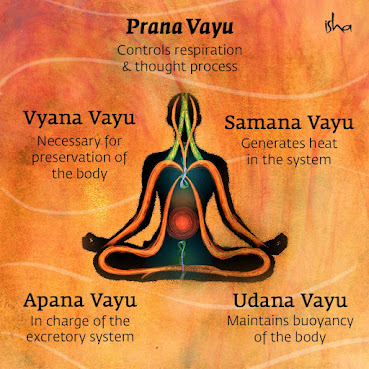The nasal cycle is an ultradian rhythm characterized by alternating patency of the left and right nostrils, with a periodicity of two to eight hours.
Respiration is the most important function of the body. Yet
most people are not aware of the simple fact that the breath does not flow
equally through the two nostrils. At times one nostril is more active than the
other, and at other times it may become less active than the other.
In a healthy human,
the breath alternates between left and right nostril throughout the day.
The pattern can vary but one nostril is typical dominant for about 88 minutes,
followed by only two minutes where there is equal air entry through both
nostrils and then it switches to the other nostril.
Some activities benefit from a more dominant push
impulse and some from a more dominant pull-back impulse. Accordingly, we can
undertake activities that our nervous system is more conducive to
at a given time.
For example, physical exercise, emptying bowels,
arguments etc are better done when the right nostril is more open (i.e. pushimpulse). Undertaking these activities during the left nostril time will be
unproductive or may even cause problems and diseases.
Similarly, enjoying nice music, going to sleep,
reading a nice book etc are better done when the left nostril is more open (i.e.
pull-back impulse). Attempting them during the right nostril time can cause
problems.
If one puts pressure under the armpit
corresponding to the currently dominant nostril, brain will automatically
switch to the other nostril!
Suppose right nostril is more open and one wants
to switch to the left nostril. One needs to apply pressure under the right
armpit.
In yogic thoughts the right nostril along with the right half of the body carries a warming SOLAR energy. It connects to the Pingala Nadi. In Ayurveda the Pitta dosha relates to the right solar Nadi.
The power of Pitta gets increased when the breath flows through the right nostril which will improve
• Circulation
• Bodily heat
• Digestion
• Perception
The left nostril along with the left half of
the body carries the LUNAR energy and connects to Ida Nadi. In Ayurveda
the Kapha dosha relates to the Ida Nadi. When the breath flows through it, it
will promote
• Sleep
• Relaxation
• Tissue formation
• Bodily coolness
This can also
explain why you might feel more irritable, increased heat sensation or
disturbed sleep if your left nostril is blocked while you might experience more
heaviness, coolness, sluggishness if your right nostril is blocked. When our sinuses
are blocked, we cannot receive our proper prana which will result in an imbalance
of body and mind.
On a spiritual level the right nostril breathing
develops Shiva energy (the cosmic masculine force) and the left side
breathing develops Shakti energy (the cosmic feminine force).
One of the aims of yogic breathing techniques is
to equalize the airflow in the nostrils.
1. Go to the toilet when right nostril is flowing and
urinate when the left nostril is flowing.
2. Eat meals when right nostril is flowing and drink
water when the left is flowing.
3. Go to bed at night when right nostril is flowing and
rise when the left is flowing.
4. When you leave home, step out with the foot
corresponding to the nostril in which the breath is flowing.
5. Start a long journey when left nostril is flowing and
enter other houses when the right is flowing.
6. During the day, left nostril dominance is auspicious
and at night right nostril flow is favourable for good health and longevity.
7. Public speaking, studying and learning are favourable
when the right nostril flows.
8. Meditation, mantra chanting, starting any
auspicious work such as construction, entering a new house, opening a new
business etc. are favourable in left nostril dominance. Avoid all external
material work in Sushumna Nadi. (Both nostril dominance) all work done in Sushumna Nadi
becomes fruitless.
When the sympathetic system is dominant on the right side and
parasympathetic system is dominant on the left, you get:
§
Right nostril dominance
§
Right lung dominant
§
Generally, more active state
§
Locomotor activity increased
§
Heart rate increased
§
Blood pressure increased
§
Respiration rate increased
§
Body temperature increased
§
Cortisol increased
§
Prolactin secretion reduces
§
Testosterone increased
§
Endorphins increased
When
the sympathetic system is dominant on the left side and parasympathetic system
is dominant on the right, you get:
§
Left nostril dominance
§
Left lung dominant
§
Generally, more resting state
§
Locomotor activity decreased
§
Heart rate reduced
§
Blood pressure reduced
§
Respiration rate reduced
§
Body temperature reduced
§
Cortisol reduced
§
Prolactin secretion increased
§
Testosterone reduced
§ Endorphins reduced
Healing through Swara Yoga
Swara Yoga advises changing
the dominant nostril at the first sign of any physical or mental disturbance.
Thus, the active side of the body is changed and glandular secretions
reestablish balance.
For example, in fever, one
should plug the operating nostril with a cotton ball and keep it plugged until
body temperature becomes normal again. Chronic indigestion can be cured by
cultivating a habit of eating only when the right nostril is dominant. The same
goes for eating and defecating in case of constipation. Stress created by hard
work and physical labor can be cured by lying on the right side and breathing
through the left nostril for 25 to 30 minutes. If you want to alter an unwanted
emotional state, just breath through the congested nostril for a while.
"To
lead a fulfilling life, both nostrils should be balanced. This would power our
life force and allow us to use our wisdom while being active in the world.
Practice 10 minutes of Nadi Shodhan Pranayama, also called Anulom Vilom every
day and see the magic!".
Synchronising the swara
If the right or left Swara happens to function
out of rhythm with the solar/lunar cycles, then any one of the following
methods can be used to synchronise the breath:
1. Close the active nostril and breathe through the
inactive nostril for a few minutes.
2. Inhale through the active nostril and exhale
through the inactive nostril.
3. Apply pressure to the armpit on the same side as
the active nostril. After some time, the opposite nostril will become
activated. For this purpose, the yogis have a stick called the yoga Danda which
they rest in the armpit.
4. Lie on the same side as the active nostril. In
this position you can also use any of the first three methods.
5. The external environment also influences nasal
activity. Washing the body or just the face in extremely hot or cold water
automatically changes the breath flow.
6. The type of food consumed will affect the Nadis.
Foods which heat the body, such as cayenne pepper, ginger and honey, directly
stimulate Surya Nadi, while foods that cool the system, such as ghee and
bananas, activate Chandra Nadi.
Decrease the breath, increase the life
The Swara yogis not only analysed the breath in relation to the flow of the three main Nadis. They also studied the nature of each and every breath. An average person breathes 15 times per minute, 900 times per hour or 21,600 times per day. Furthermore, according to these yogis, the length of a person's lifespan is predetermined by a certain allocated number of breaths, already recorded within the body. By knowing the number of breaths allotted for one lifetime, the lifespan can be calculated and also regulated. Slowing down the rate of breathing, for example, stretches out the lifespan, and vice versa.
BEGIN YOUR JOURNEY TO WELL-BEING AND TRANSFORMATION NOW!












